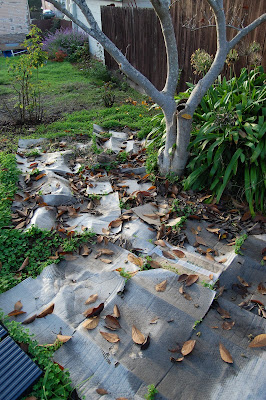

It is all located in the top of the garden at least. The ugly retaining wall kept them all up top I guess. And, well, anticipating weed growth spurts (though not this much clover) and the inability to pull them all in good time over the winter wet season, I laid out some extra cardboard in the top left side of the garden that we had from moving. They're now nicely soaked, starting to breakdown and working wonderfully.

I pulled some up last week to see what was underneath: dead yellow grass and spiders, of course, but also long yellow Oxalis that was obviously trying to find the sun and failing spectacularly. The uncovered clovers are very happy and green and I've pulled some of it - many buckets full but it's just too much for the dry time I have to devote to the chore. Luckily, we are planning on eventually having a large central gravel area in the back and a pergola with pavers underneath. Also, the one bed we have dug out is almost completely clover free. So digging helps remove the clovers. Go figure.
The second thing, obviously has to do with the poor lemon tree I wrote about in the last post. Well, just to better illustrate why we must take the drastic action of topping the tree in order to help it recover, I want to post this picture that was hiding on my home computer of the very spot that is the tree's main problem.

Enlarge this one if you doubt our reasoning. You can see that the previous owners topped the tree at the now enlarged spot. When the main leader of a tree is cut, or topped, the resulting sprouts fight to become the new leader growing oddly thick compared to normal lateral branches, and you can see on our lemon that there were branches that sprouted out in all directions from the beheaded trunk and the branch to the left sprouted a perpendicular branch which became the new leader. But topping a tree doesn't make pruning easier but more and more often necessary. These guys didn't follow up (and well, they never should have topped the tree in the first place) so all the side the branches from the topped spot grew bigger and more distorted, running into each other and warping. Eventually the one to the left cracked away from the replacement leader because it was too weak to support the weight of its canopy at the angle it had sprout from the trunk at.
So, as I said in the last post, there are just a few options open to us:
- Let well enough alone. The tree produces well over a hundred lemons a year, it seems. Downside, it's inevitable that other branches will eventually crack away and fall, hopefully on the ground, eventually killing the tree. Also, the tree would continue to be an eyesore.
- Chop down the tree wholesale. Seems a pity though to waste such a well established and well producing tree.
- Prune the tree to help keep the branches from becoming overburdened. Though, this will likely encourage growth and so might not prevent #1.
- Drastically prune the weak members and joints away. And as the entire structure of our tree is terribly weak, this means topping the tree down to just below the previous top point. AND unlike the previous owners, we will properly prune after the cut, encouraging limited stable growth.

Option one seems better :)
ReplyDelete